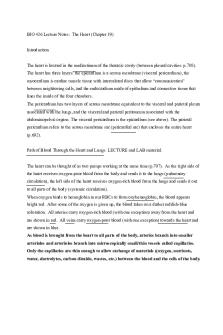Heart Sounds - Summary Medicine PDF

| Title | Heart Sounds - Summary Medicine |
|---|---|
| Course | Medicine |
| Institution | University of Dundee |
| Pages | 2 |
| File Size | 107.2 KB |
| File Type | |
| Total Downloads | 29 |
| Total Views | 139 |
Summary
Summary of heart sounds ...
Description
Sites of auscultation
Aortic valve Right 2nd intercostal space, at upper sternal border Pulmonary valve Left 2nd intercostal space, at upper sternal border Tricuspid valve Left 4th intercostal space, at lower left sternal border Mitral valve Left 5th intercostal space, just medial to mid-clavicular line th Apex beat: normal 5 ICS, mid-clavicular line HEART SOUNDS
S1 (first heart sound) caused by closure of mitral & tricuspid valves
Soft is long PR or mitral regurgitation Loud in mitral stenosis
S2 (second heart sound) caused by closure of aortic & pulmonary valves
Soft in aortic stenosis Splitting during inspiration is normal – as pulmonary being behind aortic component
S3 caused by early diastolic passive filling of ventricle
Low pitched, best heard with bell of stethoscope May occur just after S2 Normal if 30years old (may persist in women up to 50 years old) Loud S3 occurs in dilated left ventricle with rapid ventricular filling (mitral regurgitation, Ventricular Septal Defect) or poor left ventricular function (post-MI, dilated cardiomyopathy) Early & more high-pitched S3 occurs in constrictive pericarditis or restrictive cardiomyopathy
S4 caused by (forceful) atrial contraction against an active filling of stiff ventricle – always abnormal, occurs in late diastole
May be heard in aortic stenosis, hypertrophic cardiomyopathy, hypertension In hypertrophic cardiomyopathy, a double apical impulse may be felt as a result of a palpable S4
CHARACTER & TIMING Ejection-systolic murmur (ESM)
Usually originates from outflow tract May be innocent, common in children & high output states e.g. tachycardia, pregnancy
Also, caused by aortic stenosis and sclerosis, pulmonary stenosis
Pan-systolic murmur (PSM)
Uniform intensity and merges with S2 Occurs in mitral or tricuspid regurgitation, ventricular septal defect
Early diastolic murmur (EDM)
High-pitched and easily missed (listen for ‘absence of silence’ in early diastole) Occurs in aortic regurgitation - early decrescendo murmur (and pulmonary regurgitation but rare)
Mid-diastolic murmur (MDM)
Low pitched and rumbling Occur in mitral stenosis, rheumatic fever and aortic regurgitation
*Mitral murmurs loudest over apex *ESM of aortic stenosis radiates to carotids *PSM of mitral regurgitation radiates to axilla Accentuating Manoeuvres Px should lean forward and exhale for aortic regurgitation. Px should turn over to their left side for mitral stenosis. Expiration increases blood flow to left side of heart, so accentuates left-sided murmurs (vice versa for inspiration) Pericardial friction rub may be heard in pericarditis and is a superficial scratching sound, not confined to systole or diastole....
Similar Free PDFs

Heart Sounds - Summary Medicine
- 2 Pages

Heart Sounds Help Sheet
- 3 Pages

Dermatology - summary medicine
- 30 Pages

Heart of darkness summary
- 8 Pages

Medicine
- 11 Pages

Macbeth Sounds
- 1 Pages

Heart
- 8 Pages

BIO 426- The Heart summary notes
- 6 Pages

Love Medicine
- 28 Pages

IPA Vowel sounds First Exam
- 6 Pages

IPA Worksheet Vowel Sounds
- 1 Pages

Breast Medicine
- 22 Pages

Language Sounds Questions
- 2 Pages
Popular Institutions
- Tinajero National High School - Annex
- Politeknik Caltex Riau
- Yokohama City University
- SGT University
- University of Al-Qadisiyah
- Divine Word College of Vigan
- Techniek College Rotterdam
- Universidade de Santiago
- Universiti Teknologi MARA Cawangan Johor Kampus Pasir Gudang
- Poltekkes Kemenkes Yogyakarta
- Baguio City National High School
- Colegio san marcos
- preparatoria uno
- Centro de Bachillerato Tecnológico Industrial y de Servicios No. 107
- Dalian Maritime University
- Quang Trung Secondary School
- Colegio Tecnológico en Informática
- Corporación Regional de Educación Superior
- Grupo CEDVA
- Dar Al Uloom University
- Centro de Estudios Preuniversitarios de la Universidad Nacional de Ingeniería
- 上智大学
- Aakash International School, Nuna Majara
- San Felipe Neri Catholic School
- Kang Chiao International School - New Taipei City
- Misamis Occidental National High School
- Institución Educativa Escuela Normal Juan Ladrilleros
- Kolehiyo ng Pantukan
- Batanes State College
- Instituto Continental
- Sekolah Menengah Kejuruan Kesehatan Kaltara (Tarakan)
- Colegio de La Inmaculada Concepcion - Cebu


